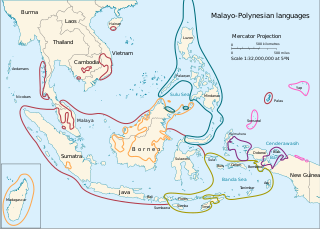Related Research Articles

The Malayo-Polynesian languages are a subgroup of the Austronesian languages, with approximately 385.5 million speakers. The Malayo-Polynesian languages are spoken by the Austronesian peoples outside of Taiwan, in the island nations of Southeast Asia and the Pacific Ocean, with a smaller number in continental Asia in the areas near the Malay Peninsula. Cambodia, Vietnam and the Chinese island Hainan serve as the northwest geographic outlier. Malagasy, spoken in the island of Madagascar off the eastern coast of Africa in the Indian Ocean, is the furthest western outlier.
Kiput is a Malayo-Polynesian language spoken in northern Sarawak, Borneo, Malaysia.

The Malayic languages are a branch of the Malayo-Polynesian subgroup of the Austronesian language family. The most prominent member is Malay, which is the national language of Brunei, Singapore and Malaysia; it further serves as basis for Indonesian, the national language of Indonesia. The Malayic branch also includes the local languages spoken by Indonesians and ethnic Malays, further several languages spoken by various other ethnic groups of Sumatra, Indonesia and Borneo. The most probable candidate for the urheimat of the Malayic languages is western Borneo.
Melanau is an Austronesian language spoken in the coastal area of the Rajang delta on northwest Borneo, Sarawak, Malaysia and Brunei. There are several dialects—Mukah-Oya, Balingian, Bruit, Dalat, Lawas, Igan, Sarikei, Segahan, Prehan, Segalang, and Siteng.

Lun Bawang or Lundayeh is the language spoken by the Lun Bawangs. It belongs to the Malayo-Polynesian family.
The Kayanic or Kayan–Murik languages are a group of Austronesian languages spoken in Borneo by the Kayan, Morek Baram, Bahau, and related peoples.
The Sama–Bajaw languages are a well established group of languages spoken by the Sama-Bajau peoples of the Philippines, Indonesia and Malaysia. They are mainly spoken on Borneo and the Sulu Archipelago between Borneo and Mindanao.
The Barito languages are around twenty Austronesian languages of Indonesia (Borneo), Southern Philippines, plus Malagasy, the national language of Madagascar. They are named after the Barito River located in South Kalimantan, Indonesia.
The Greater North Borneo languages are a proposed subgroup of the Austronesian language family. The subgroup covers languages that are spoken throughout much of Borneo, as well as parts of Sumatra and Java, and Mainland Southeast Asia. The Greater North Borneo hypothesis was first proposed by Robert Blust (2010) and further elaborated by Alexander Smith. The evidence presented for this proposal are solely lexical.
The Sabahan languages are a group of Austronesian languages centered on the Bornean province of Sabah.
The North Sarawakan languages are a group of Austronesian languages spoken in the northeastern part of the province of Sarawak, Borneo, and proposed in Blust.

Kelabit is one of the most remote languages of Borneo, on the Sarawak–North Kalimantan border. It is spoken by one of the smallest ethnicities in Borneo, the Kelabit people.
The Greater Central Philippine languages are a proposed subgroup of the Austronesian language family, defined by the change of Proto-Malayo-Polynesian *R to *g. They are spoken in the central and southern parts of the Philippines, and in northern Sulawesi, Indonesia. This subgroup was first proposed by Robert Blust (1991) based on lexical and phonological evidence, and is accepted by most specialists in the field.
Molbog is an Austronesian language spoken in the Philippines and Sabah, Malaysia. The majority of speakers are concentrated at the southernmost tip of the Philippine province of Palawan, specifically the municipalities of Bataraza and Balabac. Both municipalities are considered as bastions for environmental conservation in the province. The majority of Molbog speakers are Muslims.

Bisaya, also known as Southern Bisaya, Brunei Bisaya, Brunei Dusun or Tutong 1, is a Sabahan language spoken in Brunei and Sarawak, Malaysia.
Mainstream Kenyah, also known as Usun Apau and Bakung, is a Kayan dialect cluster of North Kalimantan, Indonesia, and Sarawak, Malaysia. Dialects fall into four clusters:
Bintulu or Vaie is an Austronesian language of Borneo. Robert Blust leaves it as an isolate within the North Sarawakan languages. Ethnologue notes that it might be closest to Baram within those languages.
Sa’ban is one of the remoter languages of Borneo, on the Sarawak–Kalimantan border. The language is known as hmeu Sa'ban in the Sa'ban language.
Belait, or Lemeting, is a Malayo-Polynesian language of Brunei and neighbouring Malaysia. It is spoken by the Belait people who mainly reside in the Bruneian Belait District. There were estimated to be 700 speakers in 1995.
Rejang is an Austronesian language predominantly spoken by the Rejang people in southwestern parts of Sumatra (Bengkulu), Indonesia. There are five dialects, spread from mountainous region to the coastal region of Bengkulu, including the Musi (Musai) dialect, the Lebong dialect, the Kebanagung dialect, the Rawas (Awes) dialect, and the Pesisir dialect.
References
- ↑ Tring at Ethnologue (18th ed., 2015) (subscription required)
- ↑ "Tring". Ethnologue. Retrieved 2019-06-26.